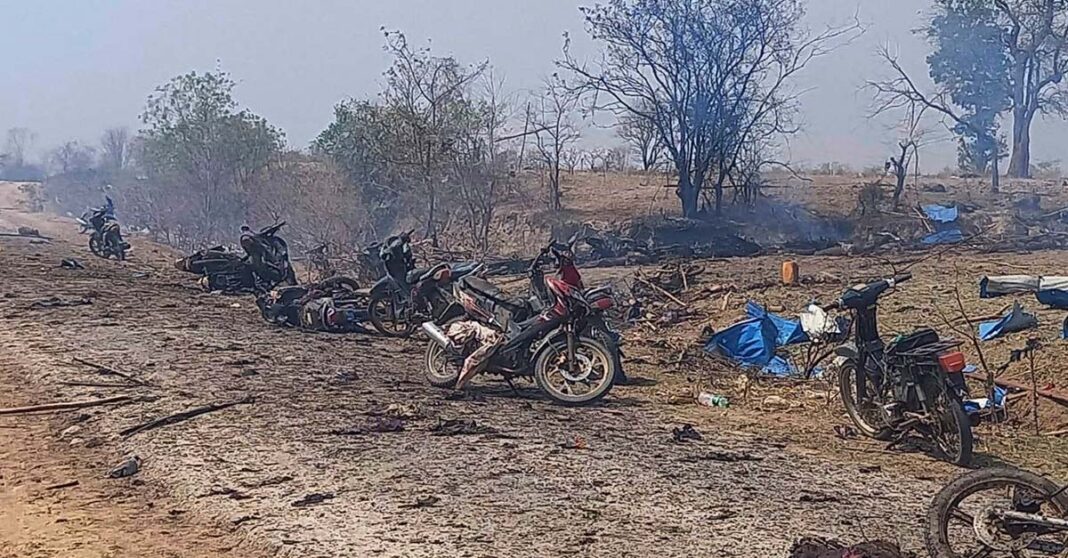BANGKOK (AP) — Myanmar’s military used an “enhanced blast” munition known as a fuel-air explosive in an airstrike that killed more than 160 people, including many children, at a ceremony held last month by opponents of army rule, a human rights monitoring group charged in a report Tuesday.
Human Rights Watch accused the military of dropping the weapon, also known as a thermobaric or vacuum bomb, on a crowd that had gathered for the opening of a local office of the country’s resistance movement outside Pazigyi village in Myanmar’s central Sagaing region on the morning of April 11. The area is about 110 kilometers (70 miles) north of Mandalay, the country’s second-largest city.
The attack caused “indiscriminate and disproportionate civilian casualties in violation of international humanitarian law, and was an apparent war crime,” the New York-based group said.
Thermobaric weapons consist of a fuel container and two separate explosive charges, with the first detonating to disperse the fuel particles and the second igniting the dispersed fuel and oxygen in the air, creating a blast wave of extreme pressure and heat that creates a partial vacuum in an enclosed space. That makes the weapon particularly deadly for people in an enclosed space, such as the office that was being opened.
Myanmar is wracked by violence that began after the army ousted the elected government of Aung San Suu Kyi in February 2021 and brutally suppressed nonviolent protests. That triggered armed resistance and combat in many parts of the country, with the military increasingly using airstrikes to counter the opposition and secure territory.
Human Rights Watch said it based its conclusion that a thermobaric weapon had been used on a review of 59 photos of the victims’ bodies and a video of the site following the attacks.
It said it also analyzed eight photographs and two videos of the remnants of the weapons posted online by the National Unity Government, an underground group that calls itself the country’s legitimate government. It presented them during a news conference three days after the bombing of the building that was supposed to be a local office for the organization.
The attack killed 168 civilians, including 40 children under 18 years old, it said. A 6-month-old girl was the youngest victim and a 76-year-old man was the oldest, the statement said. Its tally could not be independently confirmed by The Associated Press.
A witness told the AP on the day of the attack that a fighter jet dropped bombs directly onto a crowd of people and a helicopter appeared about half an hour later, firing at the site. The witness, who asked not to be identified because he feared punishment by the authorities, said those killed also included leaders of local anti-government armed groups and other opposition organizations.
Myanmar’s army acknowledged the attack but defended its actions, accusing anti-government forces in the area of carrying out a violent campaign of terror. It said the People’s Defense Forces — the armed wing of the National Unity Government — had terrorized residents into supporting them, killing Buddhist monks, teachers, and others.
The military government’s spokesperson, Maj. Gen. Zaw Min Tun told state television MRTV there was evidence the attack had set off secondary blasts of explosives hidden by the People’s Defense Forces around the site.
Human Rights Watch said that according to a witness, the People’s Defense Forces stored goods, funds, medicines, and also some ammunition in the office building, which was intended for civilian uses such as filing taxes, township meetings, and judicial processes.
“The presence of opposition combatants and ammunition would make the building a legitimate military objective subject to attack,” said Human Rights Watch.
“Even so, the use of an enhanced-blast weapon for the attack was unlawfully indiscriminate because its use in a crowded civilian area could not minimize the loss of civilian life. In addition, the initial strike and ensuing attacks on hundreds of fleeing civilians was almost certainly an unlawfully disproportionate attack, and possibly a deliberate attack on civilians.”
The use of thermobaric weapons is rarely publicly acknowledged because of the indiscriminate destruction they can cause.
The United States has used varieties of fuel-air explosives in conflicts in Vietnam, Afghanistan, and Iraq. In Afghanistan, the US Air Force dropped what it described as its “largest non-nuclear conventional weapon,” the 9,840-kilogram (21,693-pound) Massive Ordnance Air Blast Bomb.
Russia, which acknowledges producing fuel-air munitions, has been accused of using them in several conflicts, including in Ukraine. The weapons have also been reported to have been used by Azerbaijan in fighting against neighboring Armenia, and by government forces in Syria’s civil war.
___
By GRANT PECK Associated Press



